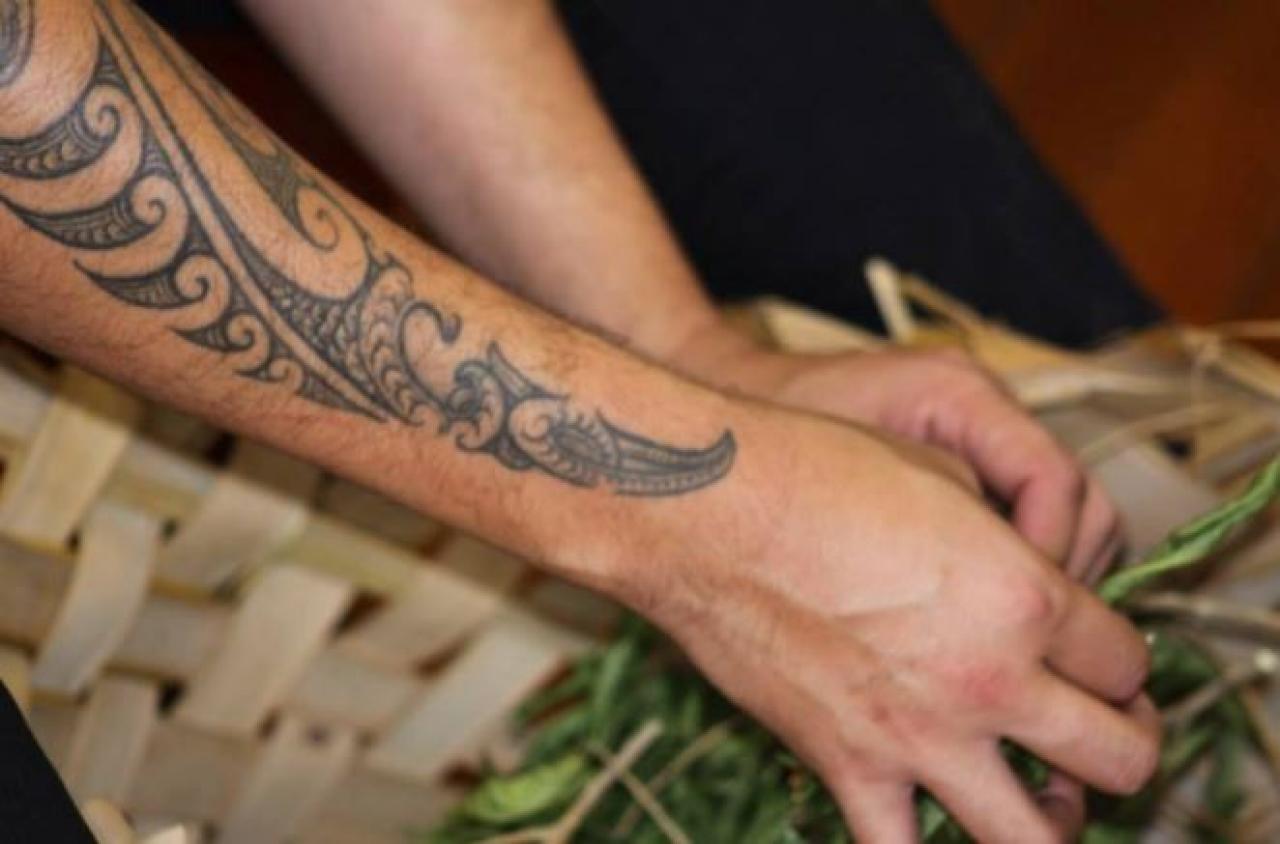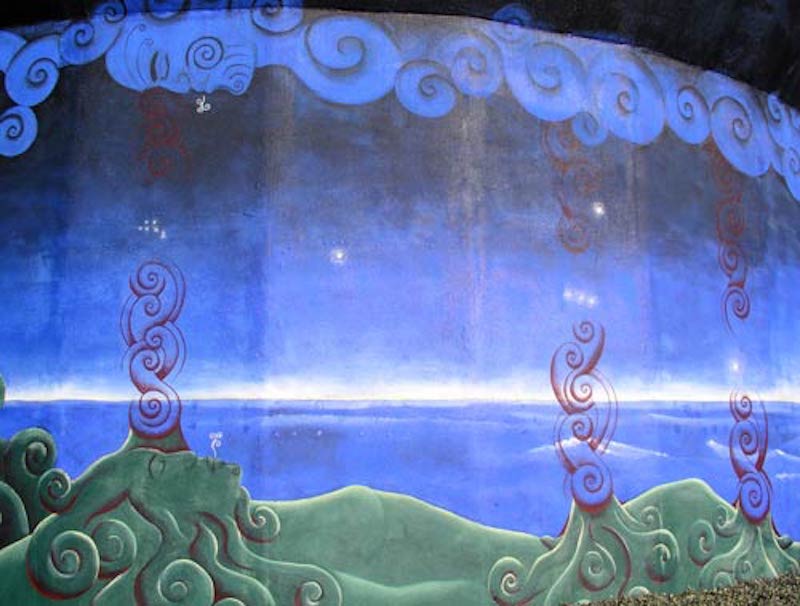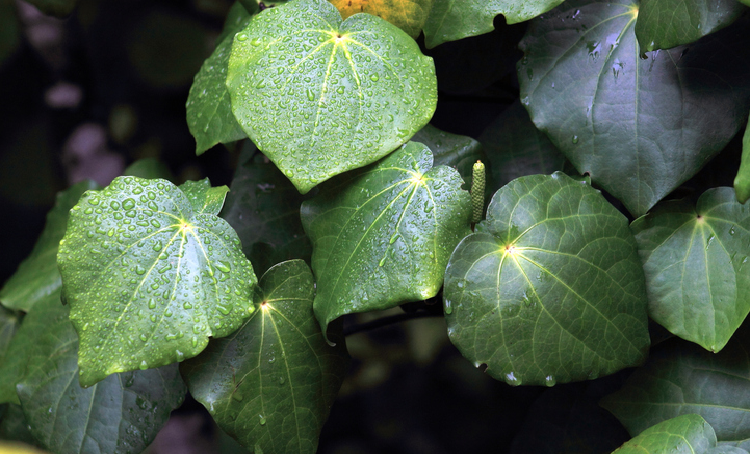
by Laura Chisale
Kia Ora Tātou, or Greetings in Te Reo Māori. The Māori have been the tangata whenua (indigenous people) of Aotearoa/New Zealand, having arrived from their Polynesian homeland of Hawaiki a millennium ago. With that, they brought knowledge and their own philosophy of Healing, natural medicine and health. To understand the depths and the place of Māori traditional herbal medicine one must understand the story of the creation of the universe through the eyes of Māori.
In the beginning there was darkness (Te Pō), the supreme being and the infinite state of nothingness. Then came Ranginui (Sky father) who is seen as the heavens and where all knowledge and life originated. Then came Papatūānuku (Earth mother) who came from under the water and arose the land giving birth to all life. The two came to exist in the darkness and held themselves together tight as one. Papatūānuku (Earth mother) and Ranginui (Sky father) had 70 sons (who were all Gods) that were held between them without light, but eventually the children become far too curious about the natural world, motiving one of their brothers Tāne Mahuta, God of forests and birds, to lay down on his back, pressing hard against his mother, and pushing his feet up in the air against his father and tore them apart to allow light to come into the world. After this, the children became Gods of various parts of our world.

Ranginui (Sky father) and Papatuanuku (Earth mother) came together in the darkness as one.
Tāne strength and will created the natural world – our forests and mountains, our oceans and seas – all before mankind. His descendent, Māui Tikitiki obtained fire for humanity, slowed the sun, and fished up land from the ocean. The North Island, Te Ika a Māui, is Maui’s fish, and the South Island, Te Waka a Māui is his canoe. The Māori worldview considers all living and non-living things to be interconnected. Humans, plants, and animals all originated from Ranginui (sky father) and Papatuanuku (earth mother) and their descendants, indicating that humans are closely intertwined with biodiversity. It is through the natural world that the link between man and their ancestors remains. This concept follows us towards understanding the Māori beliefs of the meaning of life, which is that all things have a type of soul – the wairua. All things are thought to contain a life force or mauri(power). The Māori people believe that the meaning of life is many things, but the key meaning is love. Love is immunity. Life is the beginning of ends to start again. This follows up to understanding what one’s purpose is, and that is to live in the eyes of their Gods, serving them and doing as they would want them to do.
Rongoā Māori is the traditional healing system of Māori.
It focuses on the oral tradition of knowledge, diversity of practice and the spiritual dimension of health. An essential aspect of Rongoā Māori and its practices is the connection between healers and nature, known as their whenua (landscape), iwi (tribe), hapū (sub-tribe) and whānau (extended family). At the center to this understanding, there are three dimensions of Māori knowledge—whakapapa (genealogy) as a way of knowing things, understandings of time, and the importance of the spoken word, rather than symbolic images, used to demonstrate how Māori identify themselves. This forms the base of mātauranga Māori (Māori knowledge), developed over thousands of years and based on the intricate, holistic and interconnected relationship with the natural world, recognizing as well the significance of intangible values and how landscapes shapes cultural identity (Marques et al., 2021).

The Māori cultural outlook is engraved in the ideas of hinengaro (mind), tinana (body) and wairua (spirit), this is extensively important to Rongoā healers, who need to access whakapapa (genealogy), whānau (extended family) and whenua (land) as essential aspects for healing a person’s health (Kawharu, 1970). The context of wellbeing in Māori cultures is based on 3 principles Tikanga – which is the terms of engagement with the earth, each other and our communities. These are the rules that we conduct ourselves by that are culturally appropriate in health and safety. Mauri – is the gift of life, all things have a Mauri which is a life’s essence. It is our wellbeing and our vitality that binds the physical to the spirit in order to maintain balance. Wairua lastly, is the world of connections, our connection to our ancestors to the plants and the animals. The causes of disease in Māori are ruled as ‘Loneliness’ – when we are lonely we eat food without vitality, our movement reduces, and we withdraw even more form the indiscretions we do not know how to heal from, causing a huge impact on our wellbeing spiritually and physically. ‘Hopelessness’ – this is shows up with people with addictions. ‘Homelessness’ – this is more to do with the spiritual aspect of knowing where you belong, lastly is the ‘lack of purpose beyond meeting our individual needs’ – understanding what you contribute to your community and the world beyond of your family and friends. (Dobbs & Eruera, 1970).
Rongoā Māori encompasses herbal remedies, physical therapies and spiritual healing.
These practices focus on the healing and not the just diagnosis; it is dedicated to preservation of wellbeing and not cure. The quality of one’s life plays great emphasis on Rongoā Māori practices, it does not focus on prevention of death, as death is a part of living, rather utilizing the important principle of restoring life energy (mauri) of people and of place (New Zealand Ministry for Culture and Heritage Te Manatu Taonga, 2020). In early Māori history Tohunga was the discipline of traditional healing and its practitioners and was seen as the earthly medium of the controlling spirits and influenced all aspects of life. Māori thought that certain ailments, known as mate-atua, were caused by bad spirits. A person could become ill if they violated a tapu (rule). Illness was viewed as a symptom of disharmony with nature. If a person was sick, the Tohunga would first determine what imbalance had occurred, before the illness could then be treated both spiritually and physically. While, Mate tangata – are illnesses of the physical body and were approached more pragmatically, often using herbal remedies but also in conjunction to spiritual healing (Riley 1994: 9).

Rongoā Raku (plant medicine) is about helping people reconnect with nature, it is about restoring the mauri of the natural world. The Māori believe that humanity must preserve the health of our environment and, as a result, the natural balance of all things. This connection to whenua (land) emphasizes the value of care within the Māori value system, which calls for people to be kaitiaki (caregivers) of the mauri (life force) in one another and in nature.
We are at peace when we are in harmonious relationship with ourselves and our surroundings.
In Maori folklore, it is said that plants were formed before humanity, described as being the elder relatives, they are the link between human’s ancestors of Papatūānuku (Mother Earth) and Ranginui (Sky Father).
The Māori have used their profound plant knowledge to gather and utilize the resources provided by Aotearoa ecological systems. Herbal remedies were applied through various methods, including poultices, steam baths, tonics, and various teas. Rongoā rākau involves the use of plant medicinal properties and is frequently regarded as a means of connecting to the whenua (land). Rongoā is about more than just manufacturing medicine; it is about honoring nature and the symbiotic interactions between healers and plants. The bark, leaves, roots, berries and branches are carefully harvested, removing only what is needed and ensuring that nature could continue to accommodate harvesting in the future. (Marques et al., 2021)
There is a belief that Māori healers have the ability communicate with plants through their mauri (life force).
This plays a big role when using plants as medicine during the collection process as when plants are harvested, there is an acknowledgement of the spiritual world through karakia (chants) to give thanks. More significantly, there is an acknowledgement that the plants actively contribute to the healing process, even as the herbal remedies are being prepared.
Many native plants are used to cure a wide range of diseases, including colds, flu, gastrointestinal issues, genitourinary issues, and aches and pains. Plants used in Rongoā Raku must be carefully prepared since some species might be harmful if not utilized properly. The Medicines Act 1981 and the Medicines Regulations 1984 control all medicines, related products, homeopathic medicines and herbal remedies, this includes the storage of these herbal plants. Traditionally, foods and other supplies were stored in subterranean pits. Now we have plenty of bottling options but must follow the medicines acts regulations which state that Rākau Rongoā (herbal remedies) should be collected by Tohunga who must ensure that the Rongoā Appropriate tikanga (customs and rites) must be observed during the collection, preparation and storage of Rongoā. Plant material must be correctly identified, gathered from non-polluted areas and prepared safely and hygienically, preservation wise. Plants are usually crushed or dried and mixed with water or ethyl alcohol.
Some of the more common plants used in medicines were made from plants:
- Harakeke (flax) – Flax leaves or roots made into pulp, heated and put on skin infections such as boils, other preparations include juices, gums and Wounds, abscess, swelling, Ringworm, skin irritations, flatulence, toothache, Constipation, Diarrhoea, dysentery, blood purification, Ringworm, rheumatic pain, wounds, burns, sunburn, toothache, stitching wounds, splints, Gonorrhoea.
- Kawakawa – Kawakawa leaves and bark were used for cuts and stomach pains. Kawakawa was also used to make a steam baths, leaves were placed on hot stones with water poured over and the patient sat on top. These herbs have often been used for Toothache, swollen face, kidney and bowel stimulation.
- Mānuka (Red tea tree/White tea tree) – Ashes from burnt mānuka were rubbed on the scalp to cure dandruff. It is often used in the form of leaves made into tea, turned into a gum and chewed or turned into an oil. These is often recommended for illnesses associated with Kidney and urinary problems, fever, cough, Diarrhoea, dysentery, pain, healing, inflamed breasts, as a sedative and antiseptic. Manuka has been well used with new mothers for breast pain and to help facilitate the expulsion of the placenta. Manuka leaf tea was also greatly used to reduce fever.
- Kōwhai – The bark of the kōwhai tree was heated in a calabash with hot stones, and made into a poultice for wounds or to rub on a sore back.
Rongoā Māori wasn’t always so openly practiced and celebrated. European colonizers had a significant effect on traditional Rongoā Māori. Tohunga(healers) had limited ability to combat the diseases when European settlers arrived in Aotearoa, altering the environment and affecting the disease ecology of the area. This resulted in substantial morbidity and death among Māori from influenza, measles, whooping cough, and dysentery. Despite the fact that Western medicine was also relatively ineffective at the time, Māori faith in tohunga was severely altered. Non-Maori missionaries known as Pākehā attributed the spread of disease to a lack of Christian faith. Maori healers started to seem impotent causing many Māori to accept the explanation of lack of faith and turned to Christianity. Over time, the whare wānanga (schools of higher learning) which had trained tohunga started to close, causing a grave decline in the oral teachings and traditions passed down to the tohunga.

Despite the decline, many Māori continued to seek Rongoā. While some traditional and trained tohunga continued their work, others surfaced that lacked education and authority and soon became a threat to both colonizers and Maori. The Tohunga Suppression Act 1907 was enacted in response to widespread concern over the practice of “rogue” Tohunga who lacked the training and integrity of conventional Tohunga. The medical community saw Rongoā Māori as dangerous and a barrier to Māori advancement. For New Zealand, a traditional Western medical system was sought.
The Quackery Prevention Act 1908 also prohibited the practice of “quack” doctors at the time. The Tohunga Suppression Act was approved with the backing of four Māori members of Parliament, although it only applied to Tohunga whose activities were deemed damaging.
The law was never seriously enforced, with very few Tohunga being convicted. However, the major effect of the Act was to drive the practice of Rongoā Māori underground. Tohunga identities were kept hidden, and Rongoā issues were never addressed outside of Māori villages. It is now widely an appreciated thought that traditional healers should be included in national health systems, according to the World Health Organization. There is a desire for Rongoā Māori to be established inside New Zealand’s public health system and to coexist with traditional medical systems.

The Māori have made great contributions towards western medicine through their knowledge of traditional herbs in their communities as healing ingredients. In the 1990s, a group of Māori from the North Island’s East Cape discovered, in collaboration with scientist Noel Porter, that extracts from the leaves of native mānuka shrubs had an antibacterial effect. This is due to the high concentration of an active ingredient known as leptospermone. It works against the methicillin-resistant bacteria Staphylococcus aureus, that is a major issue in hospitals. The Māori were aware that many of their native plants had healing properties – mashed-up bark from the pukatea tree relieved toothache, and boiled twigs could be used to treat skin sores. The plethora of knowledge that Māori hold is incredible. Pinatoro, also known as Strathmore weed (Pimelea prostrata), has poisoned animals and was the original source of the prostratin toxin. Since then, the same compound has been isolated from a Samoan plant used in traditional medicine and shown to be active against the human immunodeficiency virus (HIV).
The introduction of western medicine and practitioners has had its ups and downs within the Māori community.
Māori are still perceived as “other” and healthcare professionals are often frightened to discuss medical issues in fear of coming off as culturally insensitive due to their lack of Maori education when treating patients. The Māori are primarily treated by mainstream health services using the biomedical model, and this may not fully suit their needs. The disparities between the treatment of illness plays a big part in this, as well as the lack of communication between the communities on integrative medicine. Often times and throughout the history of healthcare in New Zealand, western medicine doctors may push their version of healthcare and treatments to be better rather than equal in its own regard in providing help to those who need it. The impact of colonization as an explanation for poor Māori health outcomes often perplexes Pākehā (non-Maori) (Bassett-Clarke, 2021).
The Maori have used over 200 different types of plants for many different purposes, there is still much data that needs to be recorded on the results of using these plants remedies. The Ngā Tipu Whakaoranga (Plant data base) carries detailed information on how Māori used plants to survive in New Zealand, particularly before the arrival of Europeans. It is the hope that we see more Rongoā Māori practitioners, as the practice is orally passed down and many elders are now passing on. It is important to hold these traditions close and keep them alive for generations to come, so it is never forgotten and never wrongly practiced.
Citations
- Anon, Demystifying Rongoā Māori: Traditional māorihealing. Traditional Maori Healing – BPJ 13 May 2008. Available at: https://bpac.org.nz/bpj/2008/may/rongoa.aspx [Accessed March 27, 2022].
- Bassett-Clarke, D., 2021. Meeting the needs of māori. He Ako Hiringa. Available at: https://www.akohiringa.co.nz/education/meeting-the-needs-of-maori [Accessed March 27, 2022].
- Cram, F.; Smith, L.; Johnstone, W. Mapping the Themes of Maori Talk about Health. N. Z. Med. J. 2003, 116, 1–7. [Google Scholar]
- Durie, M. A Maori Perspective of Health. Soc. Sci. Med. 1985, 20, 483–486. [Google Scholar] [CrossRef]
- Dobbs, T. & Eruera, M., 1970. [PDF] Kaupapa Māori wellbeing framework: The basis for Whānau Violence Prevention and Intervention: Semantic scholar. undefined. Available at: https://www.semanticscholar.org/paper/Kaupapa-M%C4%81ori-wellbeing-framework%3A-the-basis-for-Dobbs-Eruera/742afd1e722a4b322aa45cf95328f23509e1fa5e [Accessed March 26, 2022].
- Kawharu, M., 1970. [PDF] ancestral landscapes and World Heritage from a Maori viewpoint: Semantic scholar. undefined. Available at: https://www.semanticscholar.org/paper/ANCESTRAL-LANDSCAPES-AND-WORLD-HERITAGE-FROM-A Kawharu/06c0eb29d43eb307889e262380d801b91e0c3771 [Accessed March 26, 2022].
- Marques, B., Freeman, C. & Carter, L., 2021. Adapting traditional healing values and beliefs into therapeutic cultural environments for health and well-being. International Journal of Environmental Research and Public Health, 19(1), p.426.
- New Zealand Ministry for Culture and Heritage Te Manatu Taonga, 2019. Posts and stumps – pou and tumu. Te Ara Encyclopedia of New Zealand – Te Ara Encyclopedia of New Zealand. Available at: https://teara.govt.nz/en/te-waonui-a-tane-forest-mythology/page-4 [Accessed March 25, 2022].
- New Zealand Ministry for Culture and Heritage Te Manatu Taonga, 2014. Spiritual concepts. Te Ara Encyclopedia of New Zealand – Te Ara Encyclopedia of New Zealand. Available at: https://teara.govt.nz/en/traditional-maori-religion-nga-karakia-a-te-maori/page-3 [Accessed March 25, 2022].
- New Zealand Ministry for Culture and Heritage Te Manatu Taonga, 2019. The importance of the land. Te Ara Encyclopedia of New Zealand – Te Ara Encyclopedia of New Zealand. Available at: https://teara.govt.nz/en/te-ao-marama-the-natural-world/page-4 [Accessed March 25, 2022].
- New Zealand Ministry for Culture and Heritage Te Manatu Taonga, 2020. Understanding Rongoā. Te Ara Encyclopedia of New Zealand – Te Ara Encyclopedia of New Zealand. Available at: https://teara.govt.nz/en/rongoa-medicinal-use-of-plants/page-1 [Accessed March 26, 2022].
- Riley, M. 1994. Maori Healing and Herbal. New Zealand Ethnobotanical Sourcebook. Paraparaumu, New Zealand: Viking Sevenseas.
